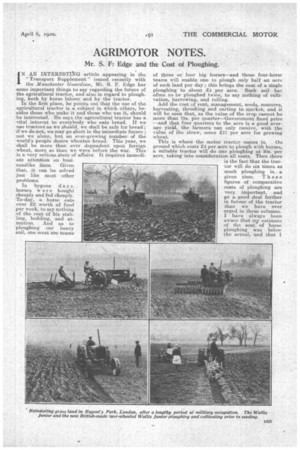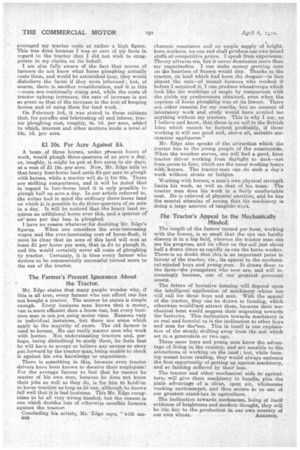AGRIMOTOR NOTES.
Page 25

Page 26

If you've noticed an error in this article please click here to report it so we can fix it.
Mr. S. Ft Edge and the Cost Of Ploughing.
I N AN INTERESTIRG article appearing in the
"Transport Supplement" issued recently with the Manchester Guardian, Mr.. S. F. Edge has some important things to say regarding the future of the agricultural tractor, and also in regard to ploughing, both by horse labour . and by the tractor. In the first place, he points out that the use of the agricultural tractor is a subject in which others, besides those who make it and those who use it, should be interested. He says the agricultural tractor has a vital interest to everybody who eats bread. If we use tractor i as we should, we shall be safe for bread;
• if we do not, we may go short in the immediate future ; not we alone, but an ever-growing numberof the world's people desire wheaten bread. This year, we shall be more than ever dependent upon foreign wheat, more so than we were before the. war. This • is a very serious. state of affairs. It requires immediate attention on busi nesslike lines. Given that, it can be solved just like most other problems.
In bygone clays, horses were bought cheaply and fed cheaply. To-day, a horse eats over 22 worth of food per week, to say nothing of the cost of his stabling, bedding, and attention. And as to ploughing our heavy soil, one must use teams
of three or four big horses—and these four-horse teams will enable one to plough only half an acre of such land per day ; this brings the cost of a single ploughing to about 24 per acre. Such soil has often to be ploughed twice, to say nothing of cultivation, harrowing, and rolling.
Add the cost of rent, management, seeds, manures, harvesting, threshing and carting to market, and it will be seen that, as the value of the crop cannot be more than 75s. per quarter—Government fixed price —and that four quarters to the acre is a. good average yield, the farmers can only receive, with the value of the straw, some 217 per acre for growing wheat.
This is where the motor tractor comes in. On ground which costs £4 per acre to plough with horses, a suitable tractor will do one ploughing at 30s. per acre, taking into consideration all costa. Then there is the fact that the tractor will do six times as much ploughing in a given time. These figures of comparative costs of ploughing are very important, and go a good deal further in favour of the tractor than we have ever urged in these columns. I have always been aware that my estimate of the Rost, of horse ploughing was below the actual, and that averaged my tractor costs at rather a high figure. This was done because I was so sure of my facts in regard to the tractor that I did not wish to exag gerate in my claims on its behalf. • I am also fully aware of the. fact that scores of farmers do not know what. horse ploughing actually costs them, and would be astonished (nay, they would disbelieve the facts) if they were informed; but, of course, there is another consideration, and it is this —costs are continually rising and, while the costs of tractor upkeep increases, the rate of increase is not so great as that of the increase in the east of keeping horses and of using them for land work.
On February 3rd, it was stated_ in these columns that, for paraffin and lubricating-oil and labour, tractor ploughing cost, roughly, 6s. Bd. per acre, added to which, interest and other matters made a total of 12s. id. per acre.
£.1 10s. Per Acre Against £4.
A team, of three horses, under ptesent hours of work, would plough three-quarters of an acre a day, or, roughly, it might be put at five acres in six days, at a cost of £1 12s. per acre. Now, Mr. Edge tells us that heavy four-horse land oosts £4 per acre to plough with horses, while a tractor will do it for 30s. These are striking comparisons, and it will be noted that in regard to four-horse land it is only possible to plough half an_acre.a day. In our article referred to, the writer had in mind the ordinary three-horse land on which it is possible to do three-qnarters of an acre in a day. It will be noticed that the heavy land requires an additional horse over this, and a quarter of aro acre per day less is ploughed.
I have no reason whatever for doubting Mr. Edge's figures. When one considers the ever-increasing wages and the ever-increasing cost of horse-flesh, it must be clear that an aore of this land will cost at least £1 per horse per acre, that is. £4 to plough it, and 30s. would certainly cover all costs of ploughing by tractor. Certainly, it is time every farmer who desires to be commercially successful turned more to the use of the tractor.
The Farmer's Present Ignorance About the Tractor.
Mr. Edge states that many people wonder why, if this is all true, every farmer who can afford one has not bought a tractor. The answer he states is simple enough. Every business anan knows that a motor, van is more efficient than a horse van, but every business man is not yet using motor vans. Reasons vary in individual instances, but there are some which apply to the majority of eases. The old farmer is used to horses. He can really master men who work with horses. Not understanding tractors and, perhaps, being disinclined to study them, he feels that he will have to accept or believe any excuse or story put forward by the tractorman, being unable to check it against his own knowledge or experience.
There is something in this, because even tractor drivers have been known to deceive their employers! For the' average farmer to feel that he cannot be master of his own men, because he does not know their jobs as well as they do, is for him to holdf on to horse traction as long as he' can, although.he knows full well that it is bad business. This Mr. Edge recognizes to be all very wrong headed, but the reason,is one which decides lots of otherwise sensible farmers against the tractor: • Concluding his article; Mr. 'Edge says, "with me ehanicai assistance and an ample supply of bright. keen workers, we can and shall produce our own bread stuffs at competitive prices. I ipeak from experience. Theory attracts me, but it never dominates more than my experimetts. I can make money growing corn on the heaviest of Sussex weald play. Thanks to the tractor, on land which had been the. despair—in fact almost the ruin—of tenant farmers who worked it before I acquired it, I can produce whe,at!crops which look like the workings of magic by comparison with the yields my predecessors obtained, even when the expense di horse ploughing was at its lowest. There are other reasons for nay results, but no amount of laboratory work and study would have availed me anything without my tractors. This is why I say, as I believe and know, that there is no soil in the British Isles which cannot be farmed profitably, if those working it will use good and, above all, suitable mechanical appliances."
Mr. Edge also speaks of the attraction which the tractor has to the young people of the countryside. When the weather serves, one will find a good, keen tractor driver working from daylight to dark—not from seven to four, which are the usual working hours with horses. The tractor-man can do such a day's work without strain or fatigue. • Working with horses, a man's own physical strength limits his work, as well as that of his team. The tractor man does his work in a fairly comfortable seat. He is relieved of physical 'exertion, and he has the mental stimulas of seeing that his machinery is doing a large amount of tangible work.
the Tractor's Appeal to the Mechanically Minded: The length' of the furrow turned per hour, working with the horses, is so • small that the eye can hardly discern it in a big field, whereas the tractor man can see his progress, and its effect on the soil just about half a dozen times as rapidly as can the horse worker. There, is no doubt that this is an important paint in favour of the tractor, viz., its appeal to the meehanical-mindect boys and young men. It draws, these to the farm—the youngsters who now are, and will increasingly become, one of our greatest potential assets.
The future of lucrative farming will depend upon the intelligentapplication of machinery whose use will call for these boys and men. With the appeal of the tractor, they can be drawn to 'farming, which otherwise.would'Oaot attract them, because their mee ehanical bent would suggest their migrating towards thelactories. This inclination towards machinery is as real and forceful as is the inclination to other boys and men for theesea. This in itself is one explanation of the steady drifting away from the soil which set in:a generation or two, ago.
These same boys and young men know the advantage of living in the country, and are sensible to-the attractions of working on the land; but, while farming meant horse tending, they would always 'embrace the first opportunity of getting up against machinery, and so fariiiin.g suffered by their loss.
The tractor andother mechanical aids to agriculture,will give them machinery to handle, plus the plain advantage of a clean, open air, ' wholesome working environment, and thus secure to us one of our greatest. stand-bys in agriculture.
The inclination towards mechanism, being of itself evidence of brightness and modern thought, they will be the key to the production in GUY own country of our own wheat. AaanioT.




























